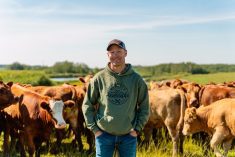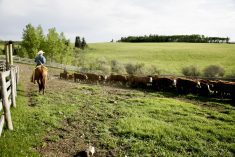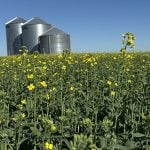Being elected president of the Canadian Cattlemen’s Association (CCA) at our annual general meeting on March 25 is an honour. It’s a role that I do not take lightly and since joining CCA’s board in 2010, I have seen first-hand the commitment and hard work put in by past CCA presidents. I am proud of our organization’s rich history and will look to our past successes and how we overcame past challenges to guide our industry to new heights.
On behalf of the CCA board, tremendous gratitude goes out to Bob Lowe for his leadership and dedication over the past two years. You have led our industry through very challenging times and despite limitations on travel, you have strengthened our relationships with policymakers, parliamentarians and industry stakeholders for the benefit of cattle producers across the country. Thank you, Bob. I look forward to continuing to work with you over the next two years in your new roles as CCA past president and chair of the Public and Stakeholder Engagement (PSE) program.
As CCA president, my goals are centred on my passion to leave a vibrant industry for the next generation. Being a part of a multi-generational ranching operation near Beechy, Sask., I understand the succession challenges facing ranching and farm families. Many of my past efforts as a CCA board member focused on initiatives to protect and preserve our industry for the next generation.
Read Also

The Canadian Cattle Association’s international advocacy efforts
Global ag policies affect Canadian food policy, so the Canadian Cattle Association participates in international and domestic forums
To protect our industry, it’s also important to be vigilant about animal health and care. A foot-and-mouth disease (FMD) outbreak is a very real threat to Canada’s livestock sector, with a potential $50 to $60 billion financial impact on the Canadian economy. Investing in a Canadian FMD vaccine bank would help prevent catastrophic losses. We continue to advocate for the federal government to establish a vaccine bank of 30 million doses, consisting of 2.5 million doses each of 12 different FMD vaccine concentrates. This is a key priority for Canadian beef producers to ensure economic viability in the future.
Enhancing the current business risk management (BRM) programs and critical infrastructure can help Canadian cattle producers manage risk, particularly during uncertain times. In 2021, we saw extreme drought and wildfires have a direct impact on beef producers from British Columbia to Ontario and the consequences will be felt by the entire industry for years. CCA’s BRM recommendations to government focus on helping producers make economically viable decisions and become more resilient to climate, market and production risks.
For example, making Livestock Price Insurance (LPI) a permanent program will help producers better manage price risk and ultimately benefit young producers, who don’t have equity to fall back on. CCA continues to ask for LPI to be made available to cattle producers in the Maritimes, as they’re currently without LPI or any similar program. LPI can also be enhanced by having the government cost-share the premiums. This would boost program enrolment and put cattle producers on a level playing field with Canadian crop producers and their American counterparts.
Innovation is a key factor in ensuring a strong and vibrant beef industry. We have the opportunity, and demonstrated ability, to continually improve our productivity and environmental performance, to better protect and preserve our air, water and soil resources. To help meet our productivity and environmental goals, increases to government core funding for research are needed.
In recent years, trade has been a real success story for our industry. For the sixth straight year, export values of Canadian beef hit record highs reaching almost $5.5 billion in 2021. CCA will continue to focus on securing access for Canadian beef in world markets. In recent years, we have seen improved trade through the implementation of the Canada-United States-Mexico Agreement, Canada-Korea Free Trade Agreement and the Comprehensive and Progressive Agreement for Trans-Partnership (CPTPP) and we strongly support free trade expansion. To help grow our export markets, we continue to share our priorities with the Canadian government when it comes to the current trade negotiations underway with the United Kingdom and the Association of Southeast Asian Countries as well as the benefit of exploring CPTPP expansion.
While we are fortunate to have many free trade agreements that have lowered tariffs on Canadian beef, many non-tariff trade barriers remain — even in markets where agreements are in place. These trade challenges need to be addressed to ensure Canadian beef producers have equal opportunities to benefit from these negotiated agreements as their counterparts. This is the case when it comes to trade with the European Union. We see a growing trade imbalance, with Canadian beef producers lacking equivalent access to this market. We are committed to working with the Canadian government to ensure that future trade agreements establish progressive trade parameters resulting in mutual benefits and strong trade relationships.
Of course, the environment and climate change will remain top of mind for government and the general public. Building on the success of Guardians of the Grasslands, Public and Stakeholder Engagement have released a new documentary titled Too Close to Home. With the rise of devastating and intense fire events across Canada, wildfire mitigation strategies are urgently needed. Grass feeds fires, but it can also feed cattle. To learn more about how we can fight fires while feeding cows and watch the documentary, visit the documentary’s website.
With a lot on the horizon, it’s an exciting time for our industry and I look forward to working with CCA board members, staff and our partners to continue to build on the momentum of my predecessors and see success for beef producers across Canada.
















